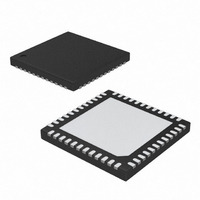MAX1978ETM+ Maxim Integrated Products, MAX1978ETM+ Datasheet - Page 13

MAX1978ETM+
Manufacturer Part Number
MAX1978ETM+
Description
IC CNTRLR INT TEMP 48TQFN
Manufacturer
Maxim Integrated Products
Datasheet
1.MAX1978ETM.pdf
(20 pages)
Specifications of MAX1978ETM+
Applications
Thermoelectric Cooler
Voltage - Supply
3 V ~ 5.5 V
Operating Temperature
-40°C ~ 85°C
Mounting Type
Surface Mount
Package / Case
48-TQFN Exposed Pad
Output Voltage Range
- 4.3 V to + 4.3 V
Output Current
6 A
Input Voltage Range
3 V to 5.5 V
Input Current
30 mA
Power Dissipation
2105 mW
Operating Temperature Range
- 40 C to + 85 C
Mounting Style
SMD/SMT
Ic Output Type
Current
Sensing Accuracy Range
± 1%
Supply Current
30mA
Supply Voltage Range
3V To 5.5V
Sensor Case Style
QFN
No. Of Pins
48
Filter Terminals
SMD
Rohs Compliant
Yes
Temperature Sensing Range
-40°C To +85°C
Lead Free Status / RoHS Status
Lead free / RoHS Compliant
Current - Supply
-
Lead Free Status / Rohs Status
Lead free / RoHS Compliant
FREQ sets the switching frequency of the internal oscil-
lator. The oscillator frequency is 500kHz when FREQ =
GND. The oscillator frequency is 1MHz when FREQ =
V
ter-capacitor values. Efficiency is optimized with the
500kHz setting.
The MAX1978 and MAX1979 provide settings to limit
the maximum differential TEC voltage. Applying a volt-
age to MAXV limits the maximum voltage across the
TEC to ±(4
The MAX1978 also limits the maximum positive and
negative TEC current. The voltages applied to MAXIP
and MAXIN independently set the maximum positive
and negative output current limits. The MAX1979 con-
trols TEC current in only one direction, so the maximum
current is set only with MAXIP. MAXIN must be con-
nected to MAXIP when using the MAX1979.
The MAX1978 and MAX1979 include a chopped input
instrumentation amplifier with a fixed gain of 50. An
external thermal sensor, typically a thermistor, is con-
nected to one of the amp’s inputs. The other input is
connected to a voltage that represents the temperature
set point. This set point can be derived from a resistor-
divider network or DAC. The included instrumentation
amplifier provides low offset drift needed to prevent
temperature set-point drift with ambient temperature
changes. Temperature stability of 0.001°C can be
achieved over a 0°C to +50°C ambient temperarure
range by using the amplifier as in Figure 1. DIFOUT is
the instrumentation amplifier output and is proportional
to 50 times the difference between the set-point tem-
perature and the TEC temperature. This difference is
commonly referred to as the “error signal”. For best
temperature stability, derive the set-point voltage from
the same reference that drives the thermistor (usually
the MAX1978/MAX1979 REF output). This is called a
“ratiometric” or “bridge” connection. The bridge con-
nection optimizes stability by eliminating REF drift as an
error source. Errors at REF are nullified because they
affect the thermistor and set point equally.
The instrumentation amplifier utilizes a chopped input
scheme to minimize input offset voltage and drift. This
generates output ripple at DIFOUT that is equal to the
chop frequency. The DIFOUT peak-to-peak ripple
amplitude is typically 100mV but has no effect on tem-
perature stability. DIFOUT ripple is filtered by the inte-
grator in the following stage. The chopper frequency is
DD
. The 1MHz setting allows minimum inductor and fil-
Chopper-Stabilized Instrumentation
Voltage and Current-Limit Settings
V
MAXV
______________________________________________________________________________________
).
Switching Frequency
Controllers for Peltier Modules
Amplifier
Integrated Temperature
derived from, and is synchronized to, the switching fre-
quency of the power stage.
An on-chip integrator amplifier is provided on the
MAX1978/MAX1979. The noninverting terminal of the
amplifier is connected internally to REF. Connect an
appropriate network of resistors and capacitors between
DIFOUT and INT-, and connect INTOUT to CTLI for typi-
cal operation. CTLI directly controls the TEC current
magnitude and polarity. The thermal-control-loop dynam-
ics are set by the integrator input and feedback compo-
nents. See the Applications Information section for
details on thermal-loop compensation.
ITEC provides a voltage output proportional to the TEC
current, ITEC (see the Functional Diagram ):
The MAX1978/MAX1979 provide open-drain status out-
puts that alert a microcontroller when the TEC tempera-
ture is over or under the set-point temperature. OT and
UT pull low when V
typical thermistor connection, this translates to approxi-
mately 1.5°C error.
The MAX1978/MAX1979 include an on-chip 1.5V volt-
age reference accurate to 1% over temperature.
Bypass REF with 1µF to GND. REF can be used to bias
an external thermistor for temperature sensing as
shown in Figures 1 and 2. Note that the 1% accuracy of
REF does not limit the temperature stability achievable
with the MAX1978/MAX1979. This is because the ther-
mistor and set-point bridge legs are intended to be dri-
ven ratiometrically by the same reference source (REF).
Variations in the bridge-drive voltage then cancel out
and do not generate errors. Consequently, 0.001°C sta-
ble temperature control is achievable with the
MAX1978/MAX1979 reference.
An external source can be used to bias the thermistor
bridge. For best accuracy, the common-mode voltage
applied to FB+ and FB- should be kept between 0.5V
and 1V, however the input range can be extended from
0.2V to V
(approximately -50µV/V) can be tolerated. This shift
remains constant with temperature and does not con-
tribute to set-point drift.
Over- and Under-Temperature Alarms
DD
V
/ 2 if some shift in instrumentation amp offset
ITEC
= 1.5V + 8
(FB1+ - FB-)
Current Monitor Output
Integrator Amplifier
is more than 20mV. For a
(V
Reference Output
OS1
- V
CS
)
13











